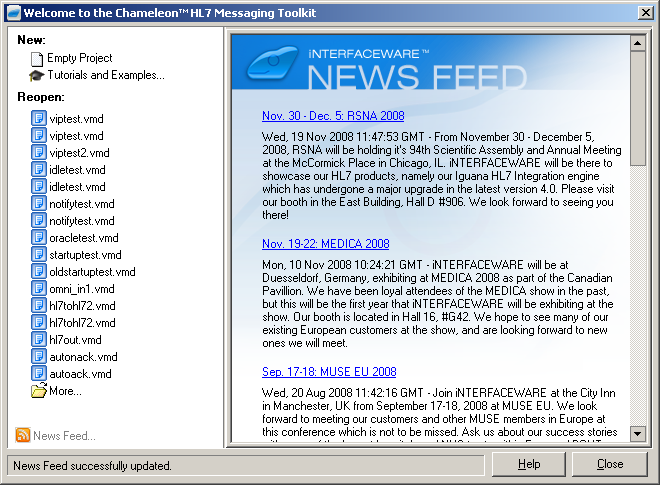

Step 2 - Setting Up the VMD File |
Now that you have some sample data to work with, the next step is to use Chameleon and this sample data to create a VMD (Visual Message Definition) file. This VMD file will contain a message definition for the input ADT^A17 messages.
- Open Chameleon. The Start Page window appears.

Start Page Window
- Under New, click Empty Project. The Message Browser appears.
| For more information about the Message Browser, see Using the Message Browser. | ||
 |

Message Browser
- Copy the sample message into the top pane of the Message Browser.
- Click Parse. Chameleon parses the message and displays the output in the bottom pane. A yellow panel appears, indicating that segments with red icons are unrecognized.

- Click the Segments with red icons are unrecognized link (which is located in the yellow panel). The Import Unrecognized Segments Window appears.

Import Unrecognized Segments Window
- By default, the Import segments from a library radio button is selected. In the list box next to this radio button, HL7 2.6 is specified. Leave these settings as is, and click Next.
|
HL7 2.6 indicates that version 2.6 of the HL7 library is being selected. This is the best version to use, as HL7 is a backwards-compatible standard. | ||
 |
- The Import Unrecognized Segments window now lists the segments that have been recognized, and asks which ones you want to import:

- Leave all of the check boxes selected. Click Next, then click Finish.
At this point, the segments are recognized, but the message itself is still not recognized. The next step is to create a message definition that matches the incoming ADT^A17 messages.
- In the Message Browser, click the Message is unrecognized link (in the yellow panel). This displays the Create Message Definition Wizard:

- Leave the Name and Description fields unchanged, and click Finish.
The message is re-parsed automatically and is now recognized:

Message Recognized
The Create Message Definition Wizard adds the new message definition to the Workspace:

The Wizard also creates the message identity for this message definition. To view the message identity, double-click the Identity link that has just been created. The Identity window appears:

The Identity Window
This indicates that the message identity for this definition is a Message Code of ADT and a Message Type of A17.
- From the File menu, select Save to save your VMD file.
Your VMD file now contains all the information it needs to recognize the incoming ADT^A17 messages. The next step is to write the Python transformation script that generates the ADT^A02 output messages. This script is described in the next section.